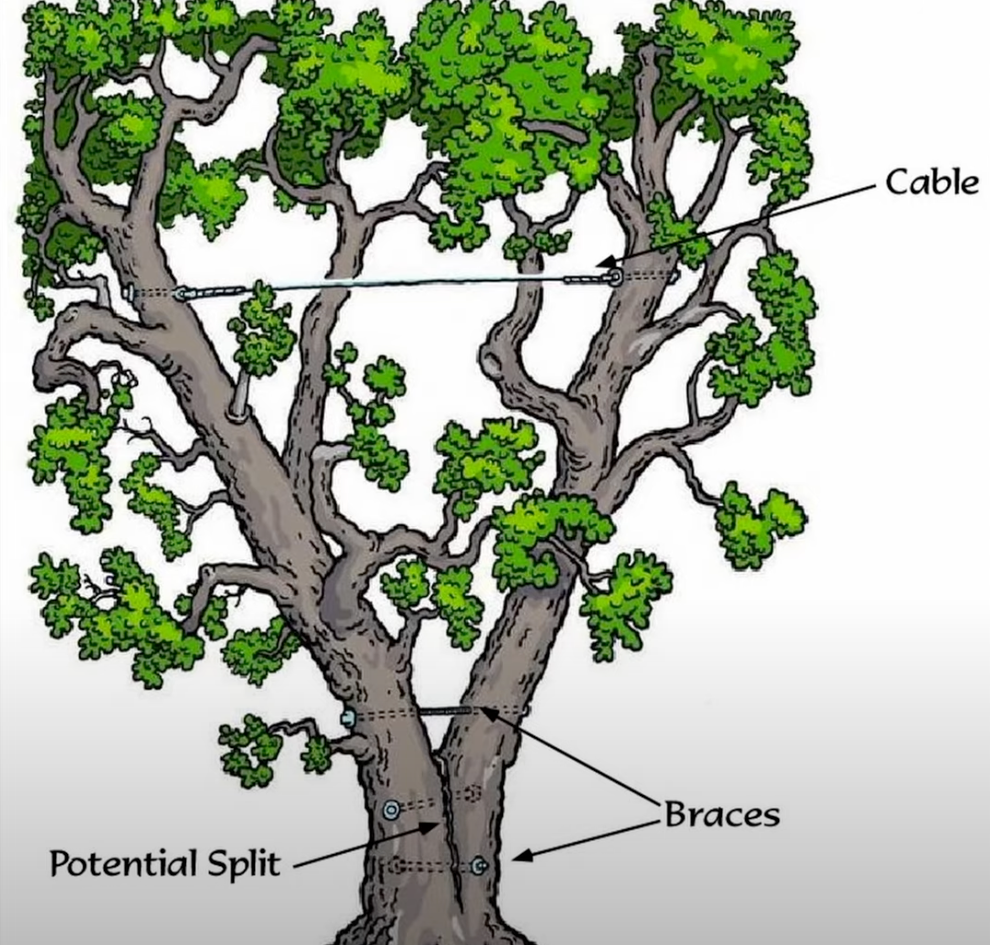Your Local Tree Service.
(615)-703-4093
How to Support Tree Limbs
Let's explore some practical tips and techniques for effectively supporting tree limbs. Properly supporting tree limbs is crucial for maintaining the structural integrity of trees and preventing damage or injury.
Some trees species are better suited to support heavily loads. Trees such as oaks, hickories, and sugar maple are known for their strong, supportive branches. However, other trees like beeches or red maples are less strong and more likely to have structural issues.
Supporting tree limbs with appropriate cabling or wiring helps alleviate stress on the branches, minimizing the potential for property damage and promoting the overall health of your trees. Let's delve into the ideal methods for cabling and wiring to bolster tree limbs and address the issue of drooping inner branches.

We will get back to you as soon as possible.
Please try again later.
Structural Defects Common to Trees
Common structural defects in trees can compromise their stability and pose safety risks if left unaddressed. Some of the most prevalent defects include:
- Codominant stems: Trees with multiple dominant stems competing for dominance can develop weak branch attachments, increasing the risk of splitting.
- Included bark: When bark becomes trapped between branch unions, it can lead to weak attachment points and potential failure.
- Co-dominant branches: Branches that emerge from the same point on the trunk without a strong central leader can create weak attachment points, making them susceptible to breakage.
- Cracks and splits: Structural defects such as cracks and splits in the trunk or branches can weaken the tree's overall structure and increase the risk of failure during storms or high winds.
Identifying and addressing these structural defects through proper pruning, cabling, or bracing techniques can help mitigate the risks and ensure the long-term health and safety of trees.
Tree Support Systems
There are several types of tree support systems, however we'll cover the most common three types. Each tree is unique and using the proper support is important to limit the movement of branches or trees. We suggest speaking with our arborists to determine the right support system for your tree.
Tree Cabling
Tree cabling involves installing cables or braces between tree branches to provide additional support and structural reinforcement. It is typically used to mitigate the risk of branch failure in trees with weak or compromised limb attachments. Tree cabling can be useful in situations where large, heavy branches pose a potential hazard to property or people. However, it may not be suitable for all trees or situations, especially if the tree's structural integrity is severely compromised or if the cabling could cause further damage. Proper assessment by one of our certified arborists is recommended to determine the appropriateness and effectiveness of tree cabling in specific cases.
Tree Bracing
Tree bracing involves using rods or braces to support weakened or damaged tree limbs or trunks. It reinforces the tree's structure and helps prevent further damage or failure. Tree bracing is useful in situations where a tree has suffered from splits, cracks, or other structural defects that compromise its stability. It can help redistribute the weight of heavy limbs and provide additional support to prevent breakage. However, tree bracing may not be suitable for all situations, especially if the tree's structural integrity is severely compromised or if the bracing could cause further harm. Professional assessment by an arborist is crucial to determine the appropriateness of tree bracing.

Tree Stakes
Tree stakes are supports used to stabilize young or newly transplanted trees. They are typically installed adjacent to the tree trunk and secured with ties to provide additional support until the tree establishes a strong root system. Tree stakes are useful for preventing wind damage, promoting upright growth, and reducing the risk of leaning or uprooting in young trees. However, tree stakes should be used judiciously and removed once the tree becomes firmly rooted to avoid restricting root development or causing girdling. Proper installation and monitoring by a knowledgeable arborist are essential to ensure the effectiveness and safety of tree stakes.
Tree Services
Service Locations
- Lebanon, TN
- Mt Juliet, TN
- Murfreesboro, TN
- La Vergne, TN
- Smyrna, TN
- Hendersonville, TN
- Gallatin, TN
Your local, trusted tree service.
Complete Tree Service of Lebanon
Our mission is to provide a safe and reliable tree service at competitive rates while maintaining customer satisfaction. We understand that each customer's situation is unique, just like each tree is unique. We will approach each project to meet your specific needs.